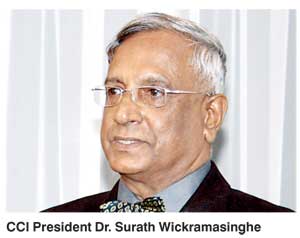Friday Jan 10, 2025
Friday Jan 10, 2025
Tuesday, 20 October 2015 00:01 - - {{hitsCtrl.values.hits}}
Build SL 2016 was launched at the Galadari Hotel on 15 October with Minister of Megapolis and Western Provincial Development Patali Champika Ranawaka as Chief Guest. Following are excerpts of the address made by CCI President Dr. Surath Wickramasinghe at the launch:
The construction industry at present is active with several mega and other projects under construction in the city of Colombo and its suburbs. Most of the urban regeneration projects include urban housing by the UDA, private sector and some of the urban housing and the bulk of the rural housing by the Ministry of Housing and Construction. In addition, there is a large spectrum of infrastructure and irrigation projects in the country.
However, with the new Government there is no visible private investment both local and foreign being approved to move the construction industry. It is important to make public that the BOI has recently reintroduced the incentives for developers/investors as  before. This will no doubt have a catalytic effect on investments resuming once again.
before. This will no doubt have a catalytic effect on investments resuming once again.
Regarding the Megapolis Development, the total area of the Western Province of Sri Lanka is 3,684 km2; which is five times larger than Singapore, while the population of both the Western Province and Singapore are about the same 5.8 million. Therefore, I sometimes wonder, whether the concept of the Megapolis development for the total Western Province, which includes Gampaha-Colombo and Kalutara districts can be achieved without the participation of all Chambers, including ours. This would make way for the Chambers to attract investment in the Megapolis.
A mega city is classified where the population exceeds 10 million. The world trends indicate that due to migration by 2025, 27 megacities will exist and 21 of these in less developed countries. Therefore, in a Sri Lankan context, we have not yet reached even one city to be classified as a mega city. The proposed Megapolis Development for the Western Province can be further fast tracked by networking with other urban nodes such as Kandy, Trincomalee , Galle and Jaffna.
Generally, speaking in mega cities the economic growth rates are higher than in other cities. However, there are also smaller mega cities with a population less than 10 million and out of these cities the best economic growth rates are the cities with a population between 1.5 to 5 million – OECD. In this context, for Sri Lanka to venture with a Mega City Concept for the Megapolis Development is appropriate.
However, as the density of population is not excessive when considering the total area of the Megapolis, the approach should be to consider a concept which will have a mix of urban and rural flavour. Therefore, the zoning and green belt additions should guide and encourage controlled urban growth.
On the other hand, a larger population is necessary to justify a Megapolis Urban Transport Network, optimising on infrastructure provided within the Megapolis and to make the investment viable and sustainable. Hence, the Megapolis concept is futuristic and beneficial for the economic growth of Sri Lanka. This should be followed by similar regional development concepts to achieve balanced development in the country.
In my view, the implementation should be done in phases, beginning with a ‘Smart City’ in selected parts within the city of Colombo and thereafter selected areas in the Megapolis areas to promote enterprises both local and international to implement their projects. To achieve this objective, the Government should prioritise the preparation of a comprehensive land use plan to cover the whole Western Province, with appropriate zoning.
The CCI comprises a multi-disciplinary professional membership with experience in physical planning, architecture, quantity surveying, valuation, surveying and engineering and many other disciplines. In addition, reputed contractors and specialist contractors can assist your ministry in many ways to ‘fast track’ the implementation of the Megapolis Development.